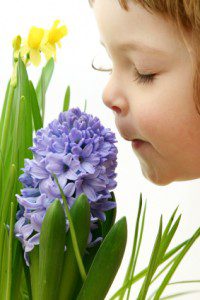 Up to your shoulder inside a cow, you feel the hot heavy squeeze of her, but I’ll never forget my startled delight the first time I withdrew my hand slowly and felt the cow’s muscles contract and release one after another, like a row of people shaking hands with me in a receiving line.
Up to your shoulder inside a cow, you feel the hot heavy squeeze of her, but I’ll never forget my startled delight the first time I withdrew my hand slowly and felt the cow’s muscles contract and release one after another, like a row of people shaking hands with me in a receiving line.
A couple of months ago I read Diane Ackerman’s A Natural History of the Senses, which inspired the Nova miniseries Mystery of the Senses and is the source for the quotation above. A Natural History of the Senses is not a new book—it was published in 1990—but Janice Moore Fuller, a writer and teacher, recommended the book at a poetry workshop I attended this summer. Fuller’s point was poets must understand the five senses; they are, finally, the only material we have with which to weave the warp and weft of poetry.
Ackerman herself is a poet, and her skill in grounding description in the vitality of the senses is everywhere apparent in A Natural History of the Senses, which reads not like a typical, thesis-driven work of nonfiction but like so many meandering letters to these loves of her life: smell, touch, taste, hearing, vision.
So What?
But why do you care if you’re not an inspiring poet like Ackerman or Fuller (or an aspiring one like I am)? Because the senses are, in the end, how we learn anything, the only way we know anything. “When scientists, philosophers, and other commentators speak of the real world,” Ackerman writes, “they’re talking about a myth, a convenient fiction. The world is a construct the brain builds based on the sensory information it’s given, and the information is only a small part of all that’s available.”
Sometimes deprivation heightens our awareness of the senses, and Ackerman uses one acute, well-known case to make this clear:
One of the greatest sensuists of all time—not Cleopatra, Marilyn Monroe, Proust of any of the other obvious voluptuaries—was a handicapped woman with several senses gone. Blind, deaf, mute, Helen Keller’s remaining senses were so finely attuned that when she put her hands on the radio to enjoy music, she could tell the difference between the cornets and the strings. She listened to colorful, down-home stories of life surging along the Mississippi from the lips of her friend Mark Twain. She wrote at length about the whelm of life’s aromas, tastes, touches, feelings, which she explored with the voluptuousness of a courtesan.
Author, advocate, and activist, Keller exemplifies a mission to learn, arguably better than any other individual.
I mention—and more, recommend—A Natural History of the Senses not for the interesting and often bizarre tidbits (the receiving-line metaphor that opens this post, for example, or “In the Elizabethan Age, lovers exchanged ‘love apples’—a woman would keep a peeled apple in her arm pit until it was saturated with her sweat, and then give it to her sweetheart to inhale.”) No, as intriguing as those morsels may be, I recommend the book primarily because of the opportunity it offers to become more conscious of the senses and how they shape our knowledge. Without the burden and gift of Keller’s disabilities, we can still learn new and exciting things from the senses we often ignore.
Now What?
So take some time today to be more conscious of the sights, sounds, smells, tastes, and touches around you. At your desk or in your yard, close your eyes; focus on the smells (an appealingly bitter aroma of coffee or the pungency of decaying leaves) and sounds (the quiet hum of the computer or the disruptive drone of an airplane). Hold some everyday object, like a stapler—discover its cool heft. You get the idea.
These are exercises not intended to teach you anything in particular. They’re meant to nurture a keen awareness of the senses, those media that moderate our interaction with the world and construct our ability to learn from it.
“It is both our panic and our privilege to be mortal and sense-full,” Ackerman writes. “We live on the leash of our senses. Although they enlarge us, they also limit and restrain us, but how beautifully.”
*******
This post was originally published on Mission to Learn. I recommend the Mission to Learn blog, which is dedicated to lifelong learning.

Pingback: Raleigh Review Workshop with Laux and Millar | Celisa Steele